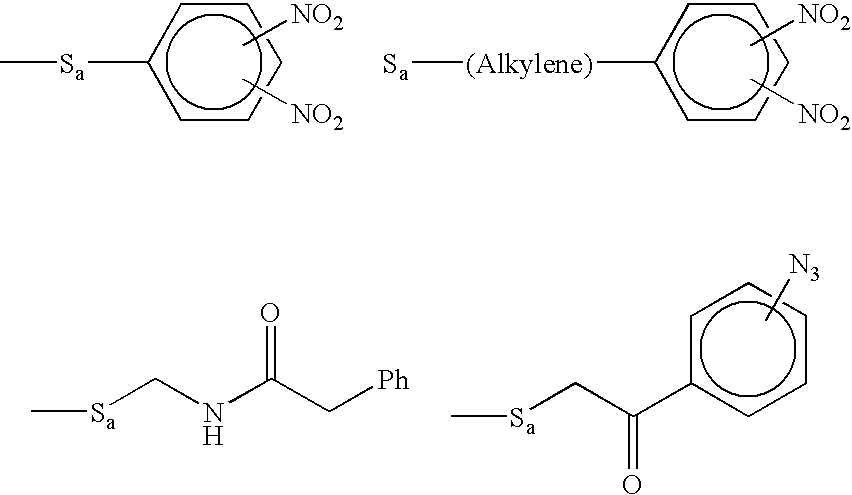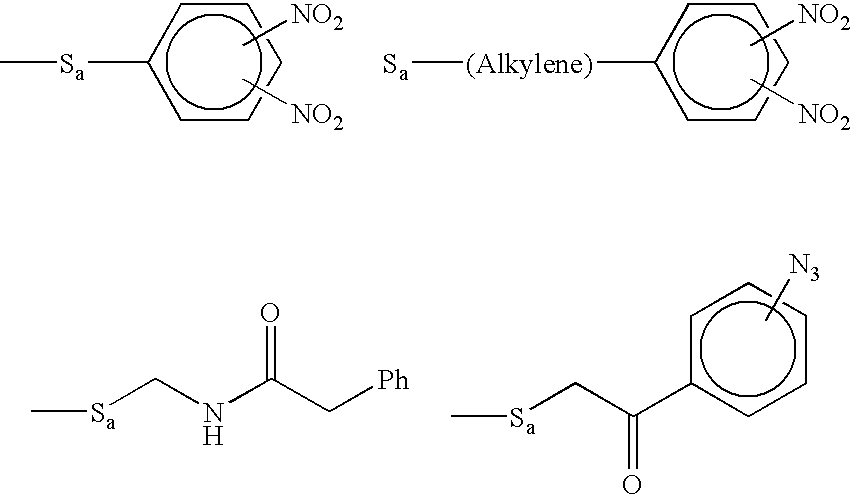Molecular detection systems utilizing reiterative oligonucleotide synthesis
a detection system and oligonucleotide technology, applied in the field of detection kits, can solve the problems of amplification methods using a thermocycling process, shortened lag time, and low sensitivity of nucleic acid probe technology
- Summary
- Abstract
- Description
- Claims
- Application Information
AI Technical Summary
Benefits of technology
Problems solved by technology
Method used
Image
Examples
example 1
RNA Primer-Initiated Abortive Transcription with an RNA Polymerase
[0489] Reaction conditions have been optimized for abortive trancription initiaton. The components and concentrations of Buffer T favor abortive transcription initiation. Buffer T is comprised of: 20 mM Tris-HCl pH 7.9, 5 AM MgCl2, 5 mM beta-mercaptoethanol, 2.8% (v / v) glycerol. Primers are either ribonucleoside-triphosphates (NTPs) or dinucleotides ranging in concentration from 0.2-1.3 mM. Final NTP concentrations range from 0.2-1.3 mM. The high ends of the concentration ranges are designed for preparative abortive transcription. The template DNA concentration is less than 2 μM in terms of phosphate. E. coli RNA polymerase is added to a final concentration of between 15 nM and 400 nM. Either holoenzyme or core can be used with a single-stranded template DNA. Yeast inorganic pyrophosphatase is added to 1 unit / ml in preparative reactions to prevent the accumulation of pyrophosphate. At high concentrations pyrophosphat...
example 2
Abortive Initiation Reaction with a Labeled Terminator
[0500] Abortive transcription initiation reactions may be performed with a labeled initiator and / or a labeled terminator. The following reaction conditions were used to incorporate a labeled terminator: [0501] 5 μl 1× Buffer T [0502] 3 μl 100 ng denatured DNA template (pBR322) [0503] 13.5 μl dd H20 [0504] 1 μl E. coli RNA polymerase [0505] 1.2 μl dinucleotide initiator ApG [0506] 1.5 μl of 7 mM SF-UTP
[0507] Incubate mixture at 37° C. for 16 hours in temperature controlled microtitre plate reader. Thin layer chromatography was performed using standard methods known in the art, and demonstrated that the labeled trinucleotide ApGpU was generated (FIG. 26).
example 3
Fluorescent Energy Transfer Between Donors and Acceptors
[0508] The above examples have demonstrated that both labeled initiators and terminators can be incorporated into the oligonucleotide products. One efficient method to measure incorporation of the labeled nucleotides is by Fluorescent Resonance Energy Transfer. The following conditions were used to demonstrate FRET between a labeled initiator and a labeled terminator: [0509] 5 μl 1× Reaction Buffer (suffer T) [0510] 3 μl denatured DNA template (300 ng pBR322) [0511] 13.5 μl dd H20 [0512] 1 μl E. coli RNA polymerase [0513] 1.2 μl Initiator (TAMARA-ApG or ApG or Biotin-ApG) [0514] 1.5 μl of of 7 mM SF-UTP
[0515] The reaction mixture was incubated at 37 C for 16 hours in temperature controlled microtitre plate reader, which was set to read at the following parameters: Ex 485, Em 620, Gain 35, 99 reads / well / cycle. Under the reaction conditions described above, the RNA polymerase reiteratively synthesizes an oligonucleotide product...
PUM
 Login to View More
Login to View More Abstract
Description
Claims
Application Information
 Login to View More
Login to View More - R&D
- Intellectual Property
- Life Sciences
- Materials
- Tech Scout
- Unparalleled Data Quality
- Higher Quality Content
- 60% Fewer Hallucinations
Browse by: Latest US Patents, China's latest patents, Technical Efficacy Thesaurus, Application Domain, Technology Topic, Popular Technical Reports.
© 2025 PatSnap. All rights reserved.Legal|Privacy policy|Modern Slavery Act Transparency Statement|Sitemap|About US| Contact US: help@patsnap.com



